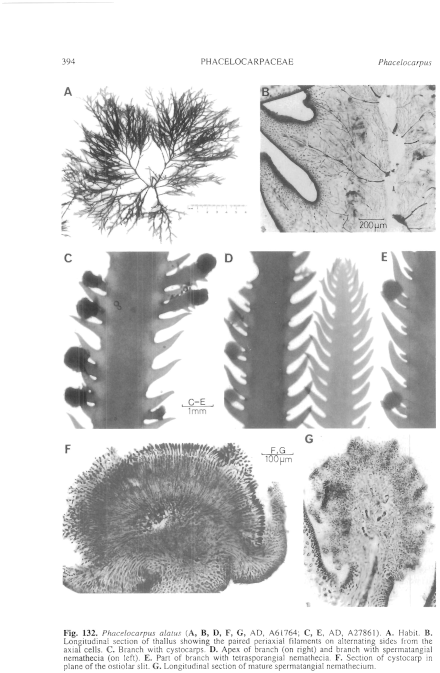|
|
|
|
|
|||||||||||
|
Electronic Flora of South Australia Species Fact Sheet
Phylum Rhodophyta – Class Florideophyceae – Order Gigartinales – Family Phacelocarpaceae
Selected citations: J. Agardh 1876: 399; 1879: 129, pl. 23 fig. 5. De Toni 1900: 391. Kylin 1932: 51, fig. 14A–C. Searles 1968: 25, figs 10,11, pl. 4b.
Thallus (Fig. 132A) medium to dark red-brown, (10–) 15–40 cm high, with a single, slightly compressed stipe 5–25 mm long and 2–3 mm broad, giving rise to several long, straight, complanately branched, compressed, main branches bearing laterals irregularly for 3–4 orders. All branches bearing distichous, compressed, alternate, pointed ramuli 500–900 (–1000) µm long, shorter than the rachis width of 750–1250 (–1500) µm, the latter with a central raised midrib and "winged" margins. Holdfast discoid, 2–4 mm across; epilithic. Structure uniaxial, developing a prominent axial filament becoming surrounded by dense rhizoids (forming the midrib), and with pairs of lateral periaxial cells (Fig. 132B) on alternate segments which develop to form the alternate ramuli. Cortex pseudoparenchymatous, inner cells ovoid and 10–20 µm in diameter, outer cells 1.5–3 µm in diameter and L/D 1–2; refractive cell inclusions conspicuous in the outer cortex; rhodoplasts discoid, few per cell.
Reproduction: All reproductive bodies borne on short to distinct stalks from the rachis, between the ramuli. Sexual thalli dioecious. Procarps in small branchlets, with two carpogonial branches and a prominent auxiliary cell. Cystocarps (Fig. 132C) stalked, 400–600 µm across, bilabiate, with a thick pericarp enclosing the carposporophyte with a basal fusion cell producing a laterally elongate tuft of gonimoblast filaments (Fig. 132F) with terminal single (–2) elongate-ovoid carposporangia 6–8 µm in diameter. Spermatangia in channels (Fig. 132G) in globular, stalked, nemathecia (Fig. 132D).
Tetrasporangia within globular, short-stalked, nemathecia (Fig. 132E) 250–400 µm in diameter, separated by tufts of sterile filaments, elongate, 40–50 µm long and 6–12 µm in diameter, zonately (often irregularly) divided.
Type from Rottnest I., W. Aust.; lectotype (Tray. Set 261) in Herb. Harvey, TCD.
Selected specimens: Parker Point, Rottnest I., W. Aust., 9 m deep (AIMS-NCI, Q66C 2690-P, 15.iii.1989; AD, A59738). Port Elliot, S. Aust., drift (Womersley, 18.x.1992; AD, A61764). Robe, S. Aust., drift (Womersley, 16.viii.1953; AD, A19044 and 18.v.1964; AD, A27861). Garden Beach, Portland Bay, Vic., drift (Beauglehole 571A, 18.viii.1951; AD, A21680). Shack Bay (between
Distribution: Rottnest I., W. Aust., and Port Elliot, S. Aust., to Walkerville, Vic.
Taxonomic notes: Inverloch and Cape Paterson), Vic., drift (Sinkora A2186, 17.x.1975; AD, A48459). Walkerville, Vic., drift (Sinkora A2586, 24.iii.1979; AD, A61000).
P. alatus is characterised by the ramuli being shorter than the rachis width, the numerous gland cells, and by all the reproductive bodies being stipitate on the rachis margin between the ramuli. Records from New Zealand (Chapman 1979, p. 325) probably all apply to Delisea compressa Levring (1955, p. 429).
References:
AGARDH, J.G. (1876). Species Genera et Ordines Algarum. Vol. 3, Part 1 - Epicrisis systematis Floridearum, pp. i-vii, 1–724. (Weigel: Leipzig.)
AGARDH, J.G. (1879). Florideernes morphologi. K. Svenska Vetensk. Akad. Handl. 15(6), 1–199, Plates 1–33.
CHAPMAN, V.J. (1979). The marine algae of New Zealand. Part DI Rhodophyceae. Issue 4: Gigartinales. (Cramer: Germany.)
DE TONI, G.B. (1900). Sylloge Algarum omnium hucusque Cognitarum. Vol. 4. Florideae. Sect. 2, pp. 387–776. (Padua.)
HARVEY, W.H. (1855a). Some account of the marine botany of the colony of Western Australia. Trans. R. Ir. Acad. 22, 525–566.
HARVEY, W.H. (1863). Phycologia Australica. Vol. 5, Plates 241–300, synop., pp. i-lxxiii. (Reeve: London.)
KYLIN, H. (1932). Die Florideenordnung Gigartinales. Lunds Univ. Årsskr. N.F. Avd. 2, 28 (8), 1–88, Plates 1–28.
LEVRING, T. (1955). Contributions to the marine algae of New Zealand. I. Rhodophyta: Goniotrichales, Bangiales, Némalionales and Bonnemaisoniales. Arkiv för Bot. Ser. 2, 3, 407–432.
SEARLES, R.B. (1968). Morphological studies of red algae of the order Gigartinales. Univ. Calif Pubis Bot. 43, vi + 1–86, Plates 1–12.
The Marine Benthic Flora of Southern Australia Part IIIA complete list of references.
Publication:
Womersley, H.B.S. (14 January, 1994)
The Marine Benthic Flora of Southern Australia
Rhodophyta. Part IIIA, Bangiophyceae and Florideophyceae (to Gigartinales)
Reproduced with permission from The Marine Benthic Flora of Southern Australia Part IIIA 1994, by H.B.S. Womersley. Australian Biological Resources Study, Canberra. Copyright Commonwealth of Australia.
Illustration in Womersley Part IIIA, 1994: FIG. 132.

Figure 132 enlarge
Fig. 132. Phacelocarpus alatus (A, B, D, F, G, AD, A61764; C, E, AD, A27861). A. Habit. B. Longitudinal section of thallus showing the paired periaxial filaments on alternating sides from the axial cells. C. Branch with cystocarps. D. Apex of branch (on right) and branch with spermatangial nemathecia (on left). E. Part of branch with tetrasporangial nemathecia. F. Section of cystocarp in plane of the ostiolar slit. G. Longitudinal section of mature spermatangial nemathecium.

|
Email Contact: State Herbarium of South Australia |

|